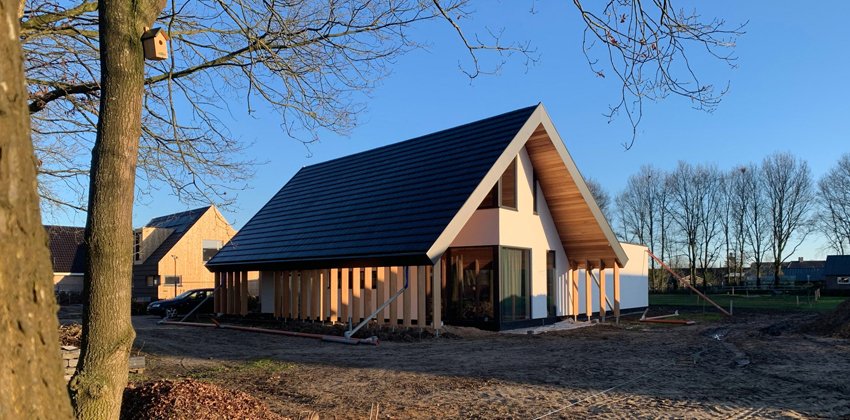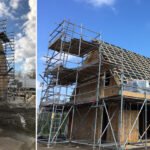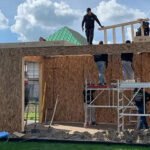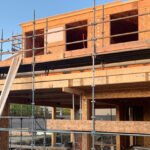
Prefab Construction as the Answer to Europe’s Housing Shortage
Europe faces one of the most pressing housing crises in modern history. Urban populations are growing, migration continues to add demand, and existing housing stock is aging rapidly. Millions of new homes are needed within the next decade, yet traditional construction methods are simply too slow, labor-intensive, and costly to meet this challenge.
Prefab construction—particularly using Structural Insulated Panels (SIPs)—offers a powerful solution. By moving much of the building process into factories, prefab reduces build times, lowers costs, and ensures higher quality. This blog explores why prefabrication is the key to addressing Europe’s housing shortage and how SIPs make it possible at scale.
Understanding the Housing Shortage
The housing gap is stark:
- The Netherlands: Over 900,000 homes needed by 2030.
- France: Demand for affordable housing exceeds 500,000 units annually.
- Spain: Growing urban centers face severe housing affordability issues.
- Germany: Migrant influx and urbanization add hundreds of thousands of units to annual demand.
Conventional construction cannot deliver homes at this speed. Projects take years to complete, and skilled labor shortages make scaling up nearly impossible. Prefab construction is not just a trend—it is a necessity.
Why Prefab Construction?
Prefab moves critical construction activities from site to factory. Panels, modules, or entire units are produced with digital precision and shipped for rapid assembly.
Benefits include:
- Speed: Projects complete in half the time compared to traditional builds.
- Labor Efficiency: Fewer workers are required, reducing dependency on scarce trades.
- Quality Control: Factory environments ensure consistent performance.
- Reduced Waste: Up to 60% less material waste compared to on-site methods.
- Cost Predictability: Fixed designs and factory production reduce budget overruns.
Prefab is ideally suited for Europe’s urgent housing needs.
Why SIPs Are the Ideal Prefab Solution
Not all prefab systems are equal. SIPs combine structure, insulation, and airtightness in a single panel, making them especially effective for large-scale housing delivery.
Key Advantages of SIP Prefab:
- Rapid Assembly – A SIP home can be erected and weather-tight within one week.
- Energy Efficiency – SIPs deliver U-values as low as 0.15 W/m²K, meeting nZEB and Passive House standards.
- Scalability – Suitable for single homes, apartment blocks, resorts, and modular housing developments.
- Durability – Resistant to mold, pests, and settlement, ensuring long-term performance.
- Flexibility – Compatible with multiple cladding systems, roof types, and interior finishes.
By combining prefab speed with energy performance, SIPs solve two challenges at once: rapid delivery and compliance with strict regulations.
Overcoming Barriers
Some barriers remain in scaling prefab SIP adoption:
- Perception of Prefab: Some stakeholders still associate prefab with low-quality “temporary” housing.
- Regulatory Complexity: Different EU countries have varying building codes, requiring adaptation.
- Industry Resistance: Contractors familiar with traditional methods may hesitate to change.
The good news is that these barriers are being overcome. Successful projects demonstrate SIP quality, EU harmonization is improving, and training programs make SIP adoption straightforward.
The Role of Quacent
Quacent is actively contributing to solving Europe’s housing shortage with:
- Ready-To-Assemble SIP Kits: Organized by construction phase, with all connectors included.
- Partnerships with Developers: Collaborating on social housing, student housing, and modular projects.
- Sustainability Compliance: Providing EPDs and LCAs to support regulatory requirements.
- Training and Support: Helping contractors transition smoothly to SIP building.
By scaling partnerships and logistics across Europe, Quacent aims to deliver thousands of SIP homes in the coming years.
Looking Ahead
Prefab construction will continue to grow as the housing crisis deepens. By 2030, experts predict that factory-built methods could represent over 30% of Europe’s new housing stock. SIPs will be at the center of this transformation, offering speed, efficiency, and sustainability in one package.
Expect to see:
- Larger Prefab Housing Developments: SIP projects delivering entire neighborhoods.
- Integration with Renewable Energy: SIP homes combined with solar panels and battery systems.
- Circular Prefab Models: Panels designed for disassembly and reuse.
- Government Incentives: Policies supporting prefab solutions for social and affordable housing.
Conclusion
Europe’s housing shortage cannot be solved with traditional methods. Prefab construction—especially with SIPs—provides the only scalable solution that delivers both speed and sustainability.
With faster assembly, superior energy performance, and adaptability across markets, SIPs are helping developers, municipalities, and policymakers meet housing needs without compromising quality.
Prefab SIP construction is not the future—it is the present, and it is Europe’s most powerful answer to the housing crisis.
Why Neopor® in SIPs Delivers Better Insulation Than Standard EPS
SEO Title: Neopor Insulation Benefits in SIPs
Meta Description: Understand why Neopor® core enhances SIP performance compared to standard EPS.
Introduction
In the world of energy-efficient construction, insulation is one of the most important factors in building performance. The type of insulation used in a Structural Insulated Panel (SIP) directly impacts energy consumption, comfort, and long-term costs.
Many SIP manufacturers use Expanded Polystyrene (EPS) as the core material. While EPS is effective, Quacent has chosen to use Neopor®, a next-generation material developed by BASF. Neopor® delivers significantly better thermal performance, durability, and sustainability compared to standard EPS.
This blog explores why Neopor® makes a difference, how it compares to EPS, and why it is the smarter choice for Europe’s future-proof buildings.
What Is Neopor®?
Neopor® is an advanced version of EPS that incorporates graphite particles into its structure. These particles reflect and absorb infrared radiation, reducing heat transfer through the insulation. The result: improved thermal performance without increasing thickness.
Key characteristics of Neopor® include:
- Improved Insulation: Up to 20% better thermal performance compared to standard EPS.
- Lightweight: Maintains the easy handling properties of EPS.
- Durability: Resistant to moisture absorption, mold, and long-term degradation.
- Sustainability: Can be recycled and contributes to lower operational energy use.
Neopor® vs. Standard EPS
While both materials are based on expanded polystyrene technology, the performance gap is clear:
- Thermal Conductivity
- Standard EPS: λ-values typically around 0.035–0.038 W/mK.
- Neopor®: λ-values as low as 0.030–0.032 W/mK.
This translates into thinner panels achieving the same U-value—or better insulation at the same thickness.
- Energy Efficiency
A SIP with Neopor® reduces heating and cooling demands by up to 20% more than a comparable EPS-core SIP. Over the building’s life, this results in substantial energy savings.
- Moisture Resistance
While EPS is moisture-resistant, Neopor® offers even greater long-term stability, making it ideal for humid or coastal climates.
- Sustainability
Both EPS and Neopor® can be recycled, but Neopor®’s improved insulation performance directly reduces a building’s operational carbon footprint.
Why Neopor® Matters for Europe
European construction is increasingly shaped by strict energy codes and sustainability goals. From Passive House standards in Germany to RE2020 in France and BENG in the Netherlands, buildings must perform at the highest level.
Neopor® makes it easier to achieve these standards:
- Thinner Walls: Better insulation in less space maximizes usable floor area.
- Lower Heating Costs: Essential in Northern climates where heating demand is high.
- Better Cooling: Important in Southern Europe, where hot summers drive energy use.
- Compliance Made Easy: U-values achievable with Neopor® align with nZEB and Passive House requirements.
Long-Term Benefits for Building Owners
For homeowners and investors, the benefits of Neopor® SIPs extend far beyond the construction phase:
- Lower Bills: Reduced heating and cooling demand means smaller energy bills year after year.
- Smaller HVAC Systems: Lower loads allow for compact heating and cooling equipment.
- Comfort: More stable indoor climates, with fewer drafts and hot/cold spots.
- Resale Value: Energy-efficient homes with better insulation command higher resale prices.
Over decades, the operational savings far outweigh the initial cost difference.
Addressing Misconceptions
Some may wonder whether Neopor® is really worth it compared to EPS. Common misconceptions include:
- “EPS is good enough”: While EPS meets basic standards, Neopor® allows compliance with stricter codes and reduces energy demand significantly.
- “Neopor® is too expensive”: The cost difference is small compared to lifetime savings and increased property value.
- “It’s harder to work with”: Neopor® retains the lightweight, easy-to-handle qualities of EPS, making it contractor-friendly.
The Role of Quacent
At Quacent, we believe in building not just for today but for decades to come. That’s why we use Neopor® in our SIPs as standard. Combined with our Ready-To-Assemble (RTA) kits and precision CNC cutting, Neopor® SIPs provide:
- Faster construction timelines.
- Superior insulation and airtightness.
- Long-term durability and moisture resistance.
- Compliance with Europe’s toughest building standards.
By choosing Neopor®, Quacent ensures that every SIP project delivers maximum comfort, efficiency, and sustainability.
Looking Ahead
As energy prices rise and sustainability targets tighten, the advantages of Neopor® will become even more valuable. Future developments in construction are likely to demand:
- Thinner, Higher-Performing Panels.
- More Circular Solutions with recyclable materials.
- Better Integration with renewable energy systems.
Neopor® positions SIPs to meet these future needs head-on, ensuring that homes built today remain efficient and valuable for decades.
Conclusion
The core of a SIP determines its performance. While EPS is functional, Neopor® provides a clear upgrade: better insulation, higher durability, and greater sustainability. For European construction—where strict energy codes, high energy costs, and climate goals define the market—Neopor® SIPs are the smarter choice.
Quacent’s commitment to using Neopor® demonstrates our focus on long-term value for homeowners, developers, and society at large. By building with Neopor® SIPs, we are not just meeting today’s standards—we are preparing for the future of energy-efficient construction.





Add a comment